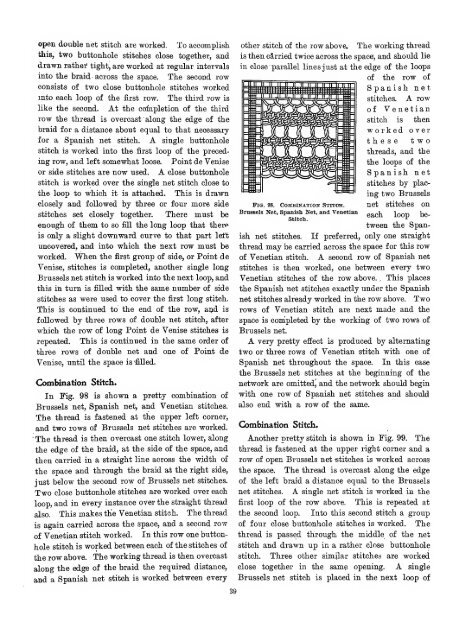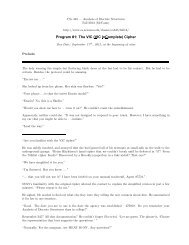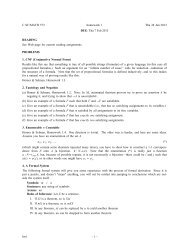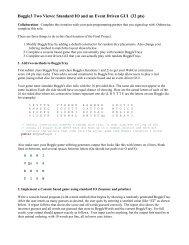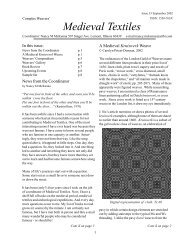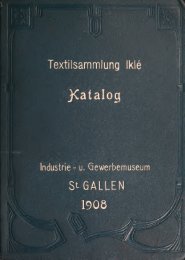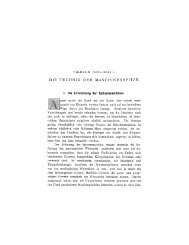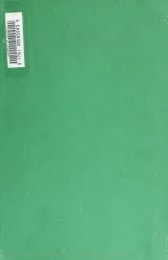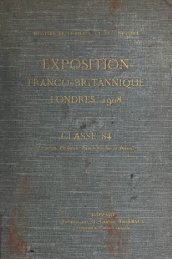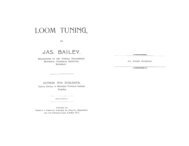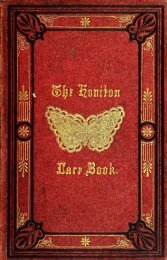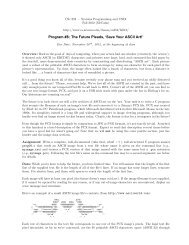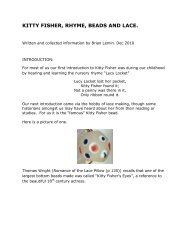The Priscilla Battenberg and point lace book; a collection of lace ...
The Priscilla Battenberg and point lace book; a collection of lace ...
The Priscilla Battenberg and point lace book; a collection of lace ...
Create successful ePaper yourself
Turn your PDF publications into a flip-book with our unique Google optimized e-Paper software.
open double net stitch are worked. To accomplish<br />
this, two buttonhole stitches close together, <strong>and</strong><br />
drawn rathei' tight, are worked at regular intervals<br />
into the braid across the space. <strong>The</strong> second row<br />
consists <strong>of</strong> two close buttonhole stitches worked<br />
into each loop <strong>of</strong> the first row. <strong>The</strong> third row is<br />
like the second. At the c<strong>of</strong>npletion <strong>of</strong> the third<br />
row the thread is overcast along the edge <strong>of</strong> the<br />
braid for a distance about equal to that necessary<br />
for a Spanish net stitch. A single buttonhole<br />
stitch is worked into the first loop <strong>of</strong> the preced-<br />
ing row, <strong>and</strong> left somewhat loose. Point de Venise<br />
or side stitches are now used. A close buttonhole<br />
stitch is worked over the single net stitch close to<br />
the loop to which it is attached. This is drawn<br />
closely <strong>and</strong> followed by three or four more side<br />
stitches set closely together. <strong>The</strong>re must be<br />
enough <strong>of</strong> them to so fill the long loop that there<br />
is only a slight downward curve to that part left<br />
uncovered, <strong>and</strong> into which the next row must be<br />
work^. When the first group <strong>of</strong> side, or Point de<br />
Venise, stitches is completed, another single long<br />
Brussels net stitch is worked into the next loop, <strong>and</strong><br />
this in turn is filled with the same number <strong>of</strong> side<br />
stitches as were used to cover the first long stitch.<br />
This is continued to the end <strong>of</strong> the row, <strong>and</strong> is<br />
followed by three rows <strong>of</strong> double net stitch, after<br />
which the row <strong>of</strong> long Point de Venise stitches is<br />
repeated. This is continued in the same order <strong>of</strong><br />
three rows <strong>of</strong> double net <strong>and</strong> one <strong>of</strong> Point de<br />
Venise, until the space is ^filled.<br />
Combination Stitch.<br />
In Fig. 98 is shown a pretty combination <strong>of</strong><br />
Brussels net, Spanish net, <strong>and</strong> Venetian stitches.<br />
<strong>The</strong> thread is fastened at the upper left corner,<br />
<strong>and</strong> two rows <strong>of</strong> Brussels net stitches are worked.<br />
thread is then overcast one stitch lower, along<br />
' <strong>The</strong><br />
the edge <strong>of</strong> the braid, at the side <strong>of</strong> the space, <strong>and</strong><br />
then carried in a straight line across the wjdth <strong>of</strong><br />
the space <strong>and</strong> through the braid at the right side,<br />
just below the second row <strong>of</strong> Brussels net stitches.<br />
Two close buttonhole stitches are worked over each<br />
loop, <strong>and</strong> in every instance over the straight thread<br />
also. This makes tKe Venetian stitch. <strong>The</strong> thread<br />
is again carried across the space, <strong>and</strong> a second row<br />
<strong>of</strong> Venetian stitch worked. In this row one button-<br />
hole stitch is worked between each <strong>of</strong> the stitches <strong>of</strong><br />
the row above. <strong>The</strong> working thread is then overcast<br />
along the edge <strong>of</strong> the braid the required distance,<br />
<strong>and</strong> a Spanish net stitch is worked between every<br />
39<br />
other stitch <strong>of</strong> the row above. <strong>The</strong> working thread<br />
is then carried twice across the space, <strong>and</strong> should lie<br />
in close parallel lines just at the edge <strong>of</strong> the loops<br />
Fig. 98. COMBINATIOK Stitoh.<br />
Brussels Xet, Spanish Net, <strong>and</strong> Venetian<br />
Stitch.<br />
<strong>of</strong> the row <strong>of</strong><br />
Spanish net<br />
stitches. A row<br />
<strong>of</strong> Venetian<br />
stitoh is then<br />
worked over<br />
these two<br />
threads, <strong>and</strong> the<br />
the loops <strong>of</strong> the<br />
Spanish net<br />
stitches by plac-<br />
ing two Brussels<br />
net stitches on<br />
each loop be-<br />
tween the Span-<br />
ish net stitches. If preferred, only one straight<br />
thread may be carried across the space for this row<br />
<strong>of</strong> Venetian stitch. A second row <strong>of</strong> Spanish net<br />
stitches is then worked, one between every two<br />
Venetian stitches <strong>of</strong> the row above. , This p<strong>lace</strong>s<br />
the Spanish net stitches exactly under the Spanish<br />
net stitches already worked in the row above. Two<br />
rows <strong>of</strong> Venetian stitch are next made <strong>and</strong> the<br />
space is conipleted by the working <strong>of</strong> two rows <strong>of</strong><br />
Brussels net.<br />
A very pretty effect is produced by alternating<br />
two or three rows <strong>of</strong> Venetian stitch with one <strong>of</strong><br />
Spanish net throughout the space. In this case<br />
the Brussels net stitches at the beginning <strong>of</strong> the<br />
network are omittedj <strong>and</strong> the network should begin<br />
with one row <strong>of</strong> Spanish net stitches <strong>and</strong> should<br />
also end with a row <strong>of</strong> the same.<br />
G>mbination Stitch.<br />
Another pretty stitch is shown in Fig. 99. <strong>The</strong><br />
thread is fastened at the upper right corner <strong>and</strong> a<br />
row <strong>of</strong> open Brussels net stitches is worked across<br />
the space. <strong>The</strong> thread is overcast along the edge<br />
<strong>of</strong> the left braid a distance equal to the Brussels<br />
net stitches. A single net stitch is worked in the<br />
first loop <strong>of</strong> the row above. This is repeated at<br />
the second loop. Into this second stitch a group<br />
<strong>of</strong> four close buttonhole stitches is worked. <strong>The</strong><br />
thread is passed through the middle <strong>of</strong> the net<br />
stitch <strong>and</strong> drawn up in a rather close buttonhole<br />
stitch. Three other similar stitches are worked<br />
close together in the same opening. A single<br />
Brussels net stitch is p<strong>lace</strong>d in the next loop <strong>of</strong>


